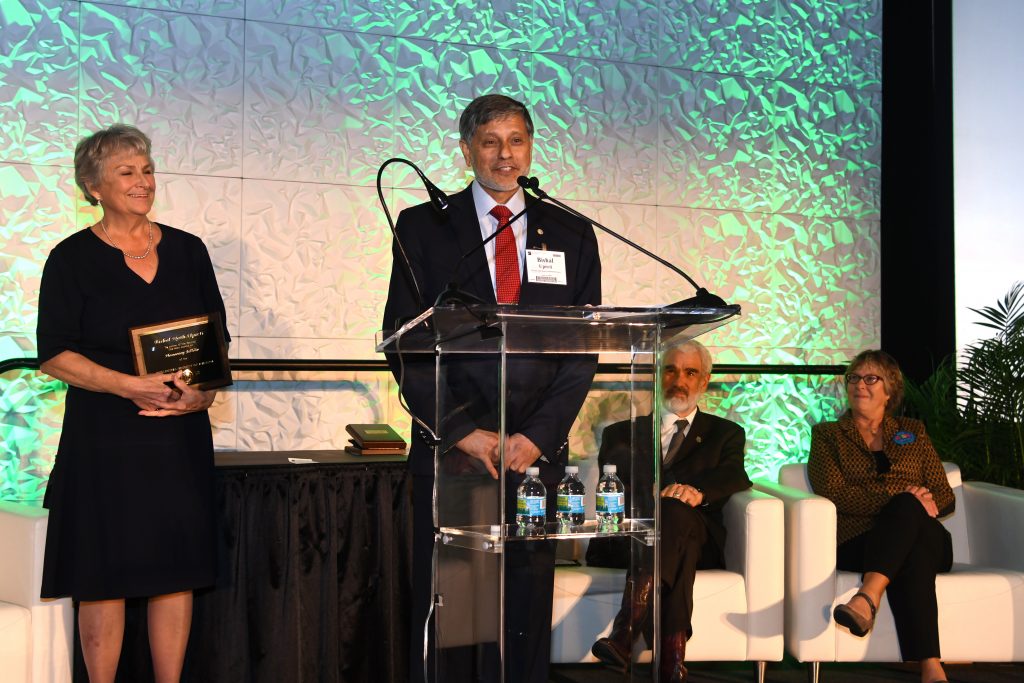SIT Nepal: Geoscience co-founder Dr. Bishal Upreti receives Geological Society of America award
November 20th, 2018 | Faculty, SIT Study Abroad

Dr. Bishal Upreti speaks at the 2018 Geological Society of America meeting.
The Geological Society of America has presented Dr. Bishal Nath Upreti, founding country director for SIT Nepal: Geosciences, with its GSA Honorary Fellow Award, given to an international scientist for “outstanding contributions to science.” The international award has been given, often to only one scientist per year, most years since 1909.
Bishal led Tribhuvan University’s geology department in Kathmandu from 1979 until 2013, and has worked in the Himalaya since 1973. “I’ve studied how the mountain range was formed, and how it is moving now – what is its history of evolution as a mountain range? We call it the ‘tectonics’ of the Himalayas.”
Bishal has been instrumental in fostering international cooperation in the region. “When outside people approach doing work and research here, there has to be somebody to collaborate with them, particularly in geology, when they’re visiting remote areas.”
During its annual meeting, the GSA noted that collaboration was a key part of his receiving the Honorary Fellow Award, saying, “Dr. Upreti has been part of or helped facilitate ideas that transformed our understanding of and impact of continental convergence with the Nepal Himalayas as the type example. He has been an important scientific ambassador to a large number of international geoscientists studying the Nepal Himalayas from a range of disciplines.”
Not only has Upreti been a major promoter of geoscience in the region, he was instrumental in co-designing SIT’s Nepal summer program Geoscience in the Himalaya with the program’s current director, Beth Pratt-Sitaula.
It began, Bishal explains, when he gave a lecture to another SIT program about the geology of Nepal’s mountains. At the time, SIT had few science programs, and he thought Nepal would be a perfect location for a new program focusing on the Himalayan mountains.
The Himalayas are a wonderful, unique place,” he says. “It’s an active mountain range, where you can see mountains is in the making. This is where two tectonic plates are colliding, making the mountains higher and even moving them. Here you can see the mountains from the roots to the top. Students love to come here, and at same time the country is a top tourist destination.”
A couple of years later, in 2014, that idea came to fruition. SIT suggested that Bishal help design and begin a summer geology program, just as he’d envisioned.
A key part of Nepal: Geosciences, he says, is that it includes Nepali students. The combined SIT and Nepali group spends the summer learning the hard skills of geology. “We study rocks, minerals, and structures, and offer students an overall understanding of the Himalaya.”
Bishal also sees it as vital that students who work in the Himalaya “are exposed to the environment in a developing country. They become lifelong friends of those places and those people. It’s a wonderful thing.”
The students do far more than sit in classrooms, and Bishal finds it important that they learn more than science. “We take students on a seven-day excursion up the Kali Gandaki Valley, a traditionally famous place to see the entire Himalayan range. They see the details of agriculture and of water use, but they also meet the people.
You can’t get that kind of experience by reading books or sitting on your couch in California,” Bishal says. “When students come back, they often become much more open, have a wider vision. They are often quite different from people who haven’t had that kind of experience.”
Just as Nepal offers so much to SIT students, Bishal says SIT has also brought a lot to Nepal. “SIT’s program is one where students can work and live with local students and professors. They can really be involved in where they are. I think that’s very important. SIT often reminds me of two programs I admire – the Fulbright program, and the Peace Corps. Having SIT students here is almost like having Peace Corps volunteers. I compare them because the students often have similar future outcomes. They know how to work hard, and they understand how to live in different conditions than they’re used to. I appreciate that. I think they always have an advantage because of it.”
Bishal has taught geology in Zambia for the past few years, but will be part of SIT Nepal once again in summer of 2019, teaching fundamentals of fieldwork and guiding students on their excursion to the Kali Gandaki Valley.
